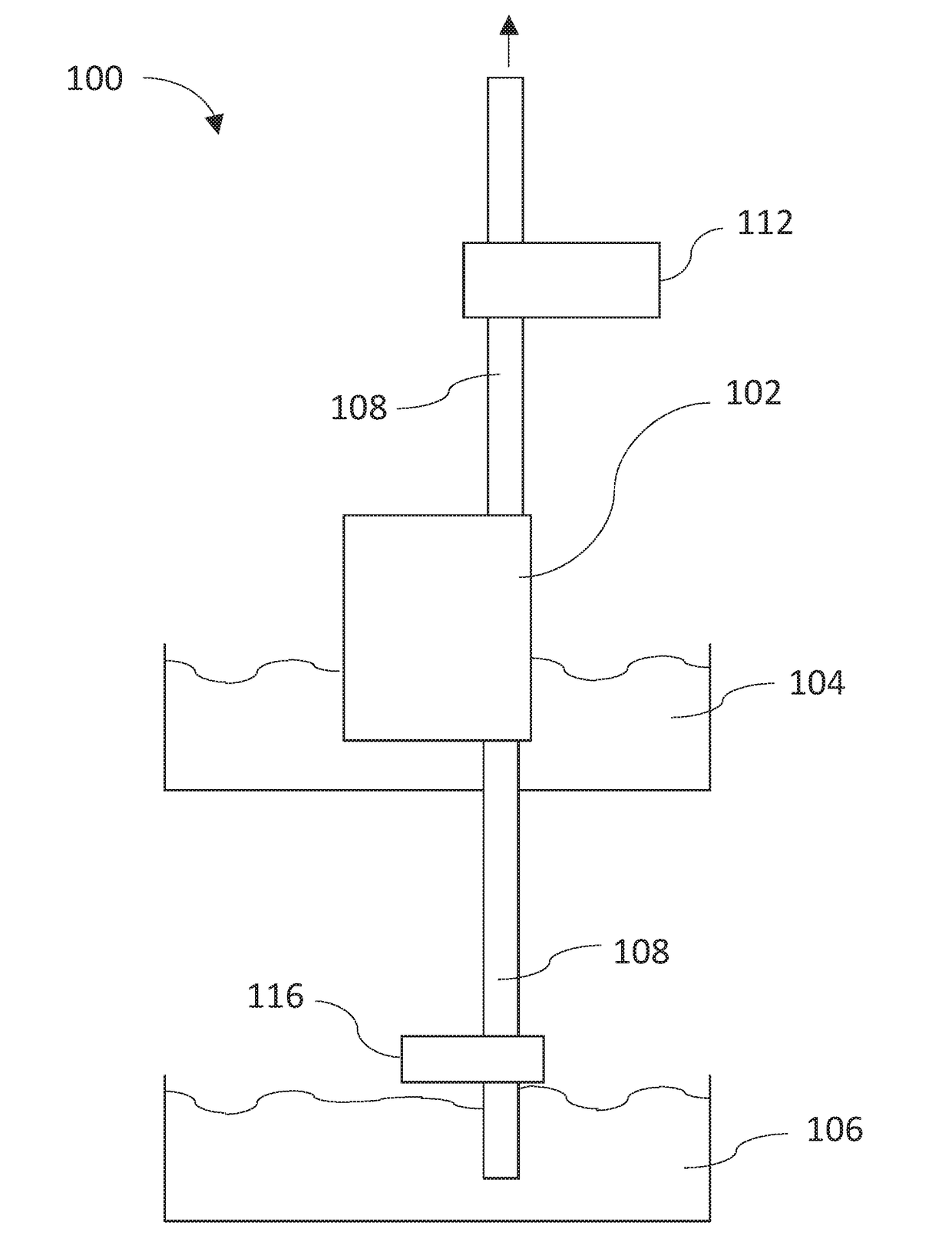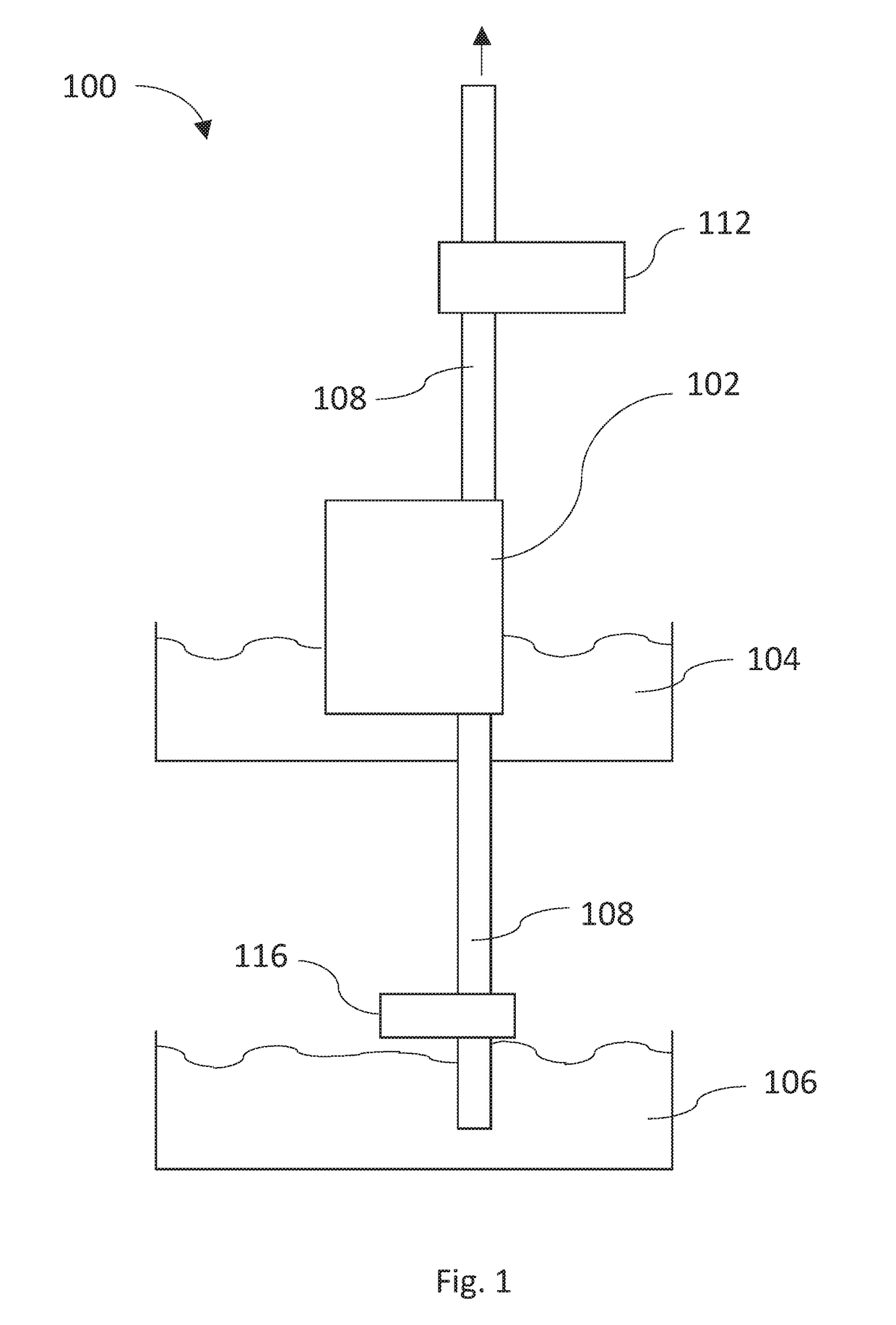System, device and method for the removal of fouling precipitates from filtration membranes
a technology of filtration membrane and fouling precipitates, which is applied in the direction of membranes, water treatment parameter control, treatment control/steering, etc., can solve the problems of reducing the performance of the membrane, irreversible mechanical damage of the membrane, and part of the flux loss, so as to achieve the effect of little or no damage to the membrane itsel
- Summary
- Abstract
- Description
- Claims
- Application Information
AI Technical Summary
Benefits of technology
Problems solved by technology
Method used
Image
Examples
example 1
[0107]An experiment has been conducted in the dewatering of saturated salt solutions from the Dead Sea of ˜28% TDS targeting salt harvesting. Currently the Dead Sea is a source of a significant part of the world's agricultural potassium. Water is pumped from the Dead Sea to a cascade of large evaporation ponds where different salts crystallize in series. Sodium chloride immediately starts a precipitation with water evaporation due to the Dead Sea being at NaCl saturation point. The salt carnallite (KCl.MgCl2.6H2O) is of a particular value because comprises the final product KCl. Most of NaCl containing in the brine should be crystalized prior to the carnallite precipitation. After the carnallite precipitates, a highly salinized brine (EB—End Brine) remains, comprising mainly CaCl2 and MgCl2 of ˜35 wt. % TDS. This brine is depleted back to the Dead Sea.
[0108]The production rate of Carnallite should be enhanced, however, unfortunately no extra evaporation area is available. In additio...
example 2
[0109]Following completion of the first ˜‘50 hour’ test, the membrane plate was drained and removed from the tank, and placed into a sealed bag prior to further testing.
[0110]Preparation of brines: The used EB and DS brines were recovered for reuse. The End Brine was heated to 55° C. and aerated for 3 days in order to evaporate the 17.5 L of water that was drawn during the past test. The Dead Sea water was heated to 55° C. and had 17.5 L of water added to it. Continuous mixing was used to completely dissolve all the solids that had precipitated during the previous test.
Testing Conditions:
[0111]Time=46.2 hr
[0112]Temperature=34.4 to 36.7° C.
[0113]Membrane Area=0.188 m2
[0114]Plate Gap=10 mm
[0115]DS CFV=41.6 cm / s
[0116]EB CFV=2.46 cm / s
[0117]Osmotic Relaxation:
[0118]Time=5 min per 60 min
[0119]Vacuum=0.65 bar
[0120]It was found that an osmotic relaxation duration of 5 min / hr combined with a predetermined pulsation was sufficient to evacuate all solids;
Results:
[0121]The test was run over 46 ...
example 3
[0125]An exemplary single 0.5 m×1.5 m×25 mm thick double sided plate having to a total of 1.5 m2 membrane area was subjected to an end brine (EB) flow, as the draw solution, inside the plate.
[0126]A test duration of 65 hours was conducted.
[0127]The EB is continuously circulated (except during osmotic relaxation) through the membrane. An EB tank on a balance is used to measure the rate of water transfer. Every ˜5 hours, the diluted EB is drained from this tank and is replaced with fresh EB due to the reduction in the driving force (osmotic potentials difference). The DS operates in a continuous feed and bleed mode while the EB is batch processed.
[0128]The original DS and EB tanks were heated to ˜35° C. and mixed to ensure homogeneity. Brine samples were taken initially and every ˜5 h during the test. Weights were measured and recorded online. Temperature values and densities were measured manually every hour. The osmotic relaxation was manually performed during 5 min every hour. Inje...
PUM
| Property | Measurement | Unit |
|---|---|---|
| pulsing frequency | aaaaa | aaaaa |
| area | aaaaa | aaaaa |
| thick | aaaaa | aaaaa |
Abstract
Description
Claims
Application Information
 Login to View More
Login to View More - R&D
- Intellectual Property
- Life Sciences
- Materials
- Tech Scout
- Unparalleled Data Quality
- Higher Quality Content
- 60% Fewer Hallucinations
Browse by: Latest US Patents, China's latest patents, Technical Efficacy Thesaurus, Application Domain, Technology Topic, Popular Technical Reports.
© 2025 PatSnap. All rights reserved.Legal|Privacy policy|Modern Slavery Act Transparency Statement|Sitemap|About US| Contact US: help@patsnap.com



